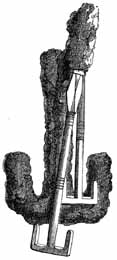|
for the handle of a box, under it a piece of thick leather.
Nos. C.—CII.—Graves of women. Two amber bead’s in CI., yellow beads
and two iron rings in CII.
No.C111.—An earthen vessel of black ware at the right foot, a sword
(broken), an umbo, and a bronze pin.
No. CIV.—A very small grave and disturbed. A knife and the top of a
sword-hilt.
|
Nos. CV. —CIX.—Beads, keys, knives (broken), a
small piece of glass, and an iron buckle; two small bronze buckles
and a black earthen vessel with a long neck. All probably women’s
graves.
No. CX.—A child’s grave, only eighteen inches deep. Three
beads.
|

|
No. CXI.—A spear-head, an umbo over the face (broken), a knife, and
several clench-bolts.
|
|
No. CXII.—No relics.
No. CXIII.—A spear-head with its socket, nearly eleven
|
inches long; an umbo, a knife, the rim of a small
bronze vessel, and on the hip a sword.
No. CXIV.—A woman’s grave; oblique. Only fragments of keys.
No. CXV.—-A woman’s grave. Two glass vessels (claw
beakers) between the
feet; the larger much fractured and too incomplete for
engraving; the lesser perfect, though with a surface more than
usually decomposed (see Plate V ., Fig. 2). Two bronze
keys, and one of iron, corroded together.1
A quantity of beads
|

|
1 See ‘The Celt, the Roman, and the Saxon,’ p.
424. |